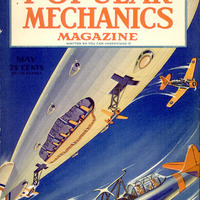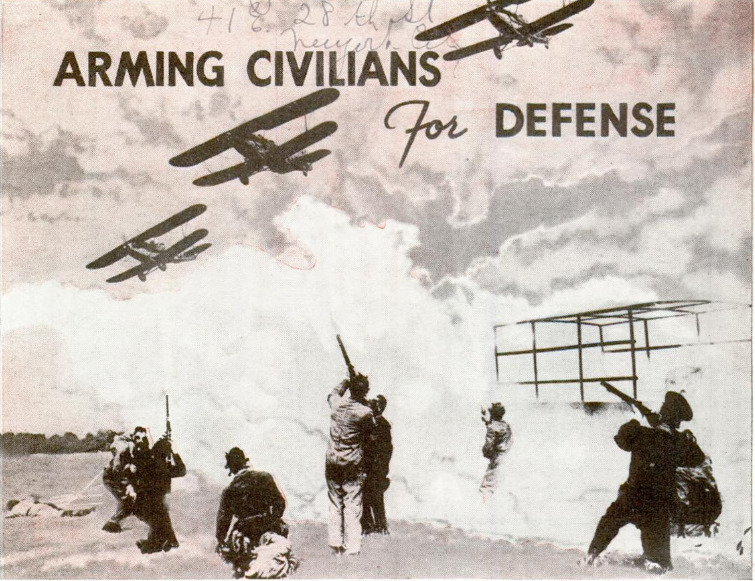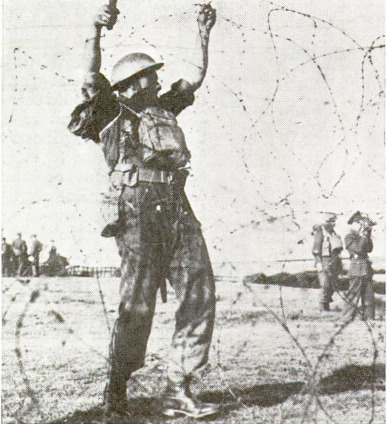DIVE bombers and tanks sweep France into helpless panic, and refugees clog roads that should be carrying armies. Fighting planes swoop down to machine-gun an English village. Armored cars roll through narrow streets of a town in the Ukraine. Picture yourself in an invaded land. What could you, a civilian, do if your home were threatened? The two foremost weapons of the blitzkrieg were planes and tanks. In the face of an air attack there are two things to do: keep your head and lie face down - in a hole if possible. Tom Wintringham, veteran of the world war and the Spanish civil war and organizer of Britain’s home guards, says, of the plane: “It is a weapon against morale. It does ot in fact kill many men.” In his “New Ways of War,” written for the English people, he advises: “Dive bombers are literally the most terrifying things that exist. There is only one thing to do about bombers: stay in a hole and pay attention to your business. Don’t look at airplanes. They see faces more easily than anything else. Keep looking where the tanks or the enemy’s infantry may appear. Then the bomber is less likely to spot you. Even if he does spot you, he is absolutely unable to hit you except by accident. Troops moving in close formation should scatter as soon as aircraft come over, but should not attempt to reach cover if it is more than 20 to 50 yards away. Break ranks, scatter, Tie still, keep faces down.” Bombers cannot capture a country. It is their function to reduce resistance, to wreck fortifications and factories, to prepare the way for tanks and infantry. The Germans concentrated bombers most heavily where their armored units were held up; therefore, if a road block is to be effective, there must be a trench or dugout nearby where the defenders can hide from aerial bombs and still cover the blockade. The tank is a formidable weapon, but the miners of Spain found & way to stop Fascist tanks in their civil war. Bringing parcels of explosives from the mines, they hid across the fields, behind trees or shrubs or in ditches. When the tanks came close, one of the miners would fling a packet of explosive, with fuse crackling, between the tank and the ground. And there was no tank! If the tank did not approach close enough, men on each side would watch the direction the tank’s guns were pointing. Bolting from cover on the safe side, one would race in to hurl his hand-made grenade. A tank’s gun can seldom turn swiftly enough nor fire at sufficiently steep angle to catch a man crouching beside it. U. S. Army units have experimented with gasoline bombs for halting tanks. This is simple and effective where the blazing gasoline penetrates into the interior of the tank. But in actual warfare, Wintringham found many a gasoline bomb lobbed on top of a tank would merely warm its roof, and if thrown on the road would splash harmlessly while the speedy tank rolled over it. Grenades containing a pound or pound and a half of explosive, he said, are far more efficient than guns, gasoline bombs of tank traps. Most vulnerable parts of a tank are its tracks and cog wheels and, in some, the relatively unarmored underside. A crowbar thrust at the right spot can disable a tank. Grenades set off by contact are useful. A man hidden in a ditch can haul a grenade across the road with a string just as the tank reaches it. The most dangerous distance from a tank is 200 yards; the safest, six inches. Motorcycle scouts that usually precede the heavier mechanized units haven’t much fire power, and offer good targets even at high speed. One stratagem that slowed Nazi cyclists on the continent was hanging a blanket on a rope across a narrow village street. When a motorcyclist comes up against such an obstacle he stops to find. what's beyond; thus halted or slowed, he can be attacked with grenades or guns. Broken glass, or nails hammered through boards, may stop an armored car or cycle. Every open field is a door ajar for the invader; the defenders must make it impossible for hostile planes to land. Trip wires can be strung across fields, about four feet high. Stout poles can be set in the ground about 50 feet apart, to knock the wings off any plane that attempts to come down. Trenches can be cut, about three feet deep and ten feet wide, one wall vertical and the other sloping, to catch the wheels of a fast-moving airplane. Should actual land invasion of the United States ever occur, it is the hope and intention of the War Department that the Army will handle the situation without being impeded by civilians. In France, refugee traffic interfered with army reinforcements and supplies. Nevertheless American civilians must cooperate in certain phases if war ever comes to this continent - in maintaining order and production, in spotting enemy ships or planes, in enforcing blackouts. And there are some phases of home defense in which America can learn from Europe. In England orders were given that automobiles not needed for defense units must be immobilized so that a competent enemy mechanic could not make them workable, else the Germans would find all the transport they needed if they captured a few towns. In Poland and France, German tanks drove up to filling stations and took gasoline from the pumps. All stations in an invaded region should be guarded, and the guards should be instructed how and when to burn the gasoline. Or the gasoline can be made temporarily useless by dumping sugar, linseed oil or similar substance into the tank. Water will not do; it simply sinks to the bottom. Home defense units preparing to face an invasion should learn first how to take cover. Tom Wintringham, organizing Britain’s home guards, told his people the Boy Scouts could teach them how to find cover and to move with as much use of cover as possible. Raw troops, he said, are eager to fight and expose themselves too much. Learn to dig a hole when lying on your stomach, and to make a valuable trench out of a useless straight ditch by cutting slots in the walls so that a man can hide from lengthwise fire along the ditch. It was an army of farmers that fought the American war for independence; an army of home guards. Civilians today could not hope to oppose a mechanized invasion, but they could help with delaying tactics. And they can learn something about the use of weapons - a rifle or shotgun, a pistol, some sort of hand grenade. To use any of these weapons correctly you must be able to gauge distance to the target. The hand grenade is a useful weapon for anyone. Any man or woman who can throw a brick should be able to do effective damage with a grenade. Actually a brick is not a bad instrument to start practicing with; lob it well up in the air to get distance. The local defense units in England were taught to press the trigger of a rifle without jerking or shaking the barrel. They practiced lying prone, or crouching behind sand bags. They learned two essentials about pistols: first, never to assume that “it isn’t loaded”; second, don’t expect to affect a man at 20 yards range with a pistol unless you are a good shot already. Unless you are thoroughly used to a pistol, all you can do is wait around a corner or behind a door where you know an enemy is likely to come, then fire at point-blank range. Men who have never fired a pistol, however, can fire fairly well as soon as they learn how to judge distance, to aim correctly and to squeeze the trigger gently and firmly. Several methods of halting tanks have already been described. One other, sometimes useful, is the antitank ditch. Dig a trench with one wall vertical and six feet high, the other wall slanted so that from ground level to the base of the vertical wall is about 15 feet. Bolster the vertical wall with cement, rails or ties, otherwise the tank could roll down the slope and grind away with its tracks until it has brought down enough earth to give it something to tread on and climb up. The sloping wall should be toward the anticipated tank attack. Near any tank trap or road block there should be bomb shelters. But ahead of the tanks come the motorcyclists. If they can be spilled off their machines, get to them quickly; grab the rider’s tommy-gun or pistol before an armored car comes along. If a motorcyclist is stopped down the road and there are no heavier vehicles in sight, the scout should be stalked with hand grenades. “No tommy-gun can possibly hit you at 500 yards,” Wintringham told the English volunteers. “At 200 yards it will not hit you if you are quick; at 100 yards or less it will cut you in half with bullets in two seconds. Keep this in mind when tackling parachutists or infantry armed with this weapon.” Machine guns are dangerous at a half mile or less but cannot drill through a strong brick wall, three feet of earth or any solid barricade. A house can be defended by knocking loopholes that command the ways of approach. Buckets of water should be handy, and blankets or curtains to cover the windows. These should be hung somewhat away from the windows so that the blast from a shell or hand grenade will not drive the glass through them. Two thick mattresses or a thick brick wall will stop a bullet. The home defender should be able to get into the attic, and to the roof if possible. Ground floor windows should be heavily barricaded, and stout timbers held ready to bolster a door against a hand grenade attack. And there must be some way for the defenders to escape; a “crawl trench” just deep enough to crawl along is sufficient. These are the new ways of war civilians around the world are learning. Behind the armies are the homes, and in these homes men and women are preparing to stand off the invading tide as it reaches their door.
 Popular Mechanics, vol. 77, n. 5, 1942
Popular Mechanics, vol. 77, n. 5, 1942





